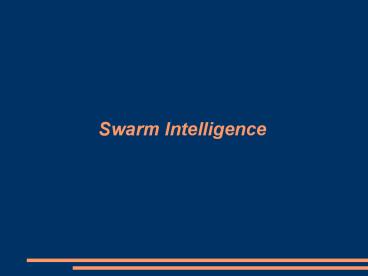Swarm Intelligence PowerPoint PPT Presentation
Title: Swarm Intelligence
1
Swarm Intelligence
2
Swarms
- Natural phenomena as inspiration
- A flock of birds sweeps across the Sky.
- How do ants collectively forage for food?
- How does a school of fish swims, turns together?
- They are so ordered.
3
What made them to be so ordered?
- There is no centralized controller
- But they exhibit complex global behavior.
- Individuals follow simple rules to interact with
neighbors . - Rules followed by birds
- collision avoidance
- velocity matching
- Flock Centering
4
Swarm Intelligence-Definition
- Swarm intelligence (SI) is artificial
intelligence based on the collective behavior of
decentralized, self-organized systems
5
Characteristics of Swarms
- Composed of many individuals
- Individuals are homogeneous
- Local interaction based on simple rules
- Self-organization
6
Overview
- Ant colony optimization
- TSP
- Bees Algorithms
- Comparison between bees and ants
- Conclusions
7
Ant Colony Optimization
- The way ants find their food in shortest path is
interesting. - Ants secrete pheromones to remember their path.
- These pheromones evaporate with time.
8
Ant Colony Optimization..
- Whenever an ant finds food , it marks its return
journey with pheromones. - Pheromones evaporate faster on longer paths.
- Shorter paths serve as the way to food for most
of the other ants.
9
Ant Colony Optimization
- The shorter path will be reinforced by the
pheromones further. - Finally , the ants arrive at the shortest path.
10
Optimizations of SI
- Swarms have the ability to solve problems
- Ant Colony Optimization (ACO) , a meta-heuristic
- ACO can be used to solve hard problems like TSP,
Quadratic Assignment Problem(QAP)? - We discuss ACO meta-heuristic for TSP
11
ACO-TSP
- Given a graph with n nodes, should give the
shortest Hamiltonian cycle - m ants traverse the graph
- Each ant starts at a random node
12
Transitions
- Ants leave pheromone trails when they make a
transition - Trails are used in prioritizing transition
13
Transitions
- Suppose ant k is at u.
- Nk(u) be the nodes not visited by k
- Tuv be the pheromone trail of edge (u,v)?
- k jumps from u to a node v in Nk(u) with
probability
puv(k) Tuv ( 1/
d(u,v))
14
Iteration of AOC-TSP
- m ants are started at random nodes
- They traverse the graph prioritized on trails and
edge-weights - An iteration ends when all the ants visit all
nodes - After each iteration, pheromone trails are
updated.
15
Updating Pheromone trails
- New trail should have two components
- Old trail left after evaporation and
- Trails added by ants traversing the edge during
the iteration
- T'uv (1-p) Tuv ChangeIn(Tuv)?
- Solution gets better and better as the number of
iterations increase
16
Performance of TSP with ACO heuristic
- Performs better than state-of-the-art TSP
algorithms for small (50-100) of nodes
- The main point to appreciate is that Swarms give
us new algorithms for optimization
17
Bee Algorithm
18
(No Transcript)
19
Bees Foraging
- Recruitment Behaviour
- Waggle Dancing
- series of alternating left and right loops
- Direction of dancing
- Duration of dancing
- Navigation Behaviour
- Path vector represents knowledge representation
of path by inspect - Construction of PI.
20
Algorithm
- It has two steps
- ManageBeesActivity()?
- CalculateVectors()?
- ManageBeesActivity It handles agents activities
based on their internal state. That is it decides
action it has to take depending on the knowledge
it has. - CalculateVectors It is used for administrative
purposes and calculates PI vectors for the agents.
21
Uses of Bee Algorithm
- Training neural networks for pattern recognition
- Forming manufacturing cells.
- Scheduling jobs for a production machine.
- Data clustering
22
Comparisons
- Ants use pheromones for back tracking route to
food source. - Bees instead use Path Integration. Bees are able
to compute their present location from past
trajectory continuously. - So bees can return to home through direct route
instead of back tracking their original route. - Does path emerge faster in this algorithm.
23
Results
- Experiments with different test cases on these
algorithms show that. - Bees algorithm is more efficient when finding and
collecting food, that is it takes less number of
steps. - Bees algorithm is more scalable it requires less
computation time to complete task. - Bees algorithm is less adaptive than ACO.
24
Applications of SI
- In Movies Graphics in movies like Lord of the
Rings trilogy, Troy.
- Unmanned underwater vehicles(UUV)
- Groups of UUVs used as security units
- Only local maps at each UUV
- Joint detection of and attack over enemy vessels
by co-ordinating within the group of UUVs
25
More Applications
- Swarmcasting
- For fast downloads in a peer-to-peer file-sharing
network - Fragments of a file are downloaded from different
hosts in the network, parallelly. - AntNet a routing algorithm developed on the
framework of Ant Colony Optimization
- BeeHive another routing algorithm modelled on
the communicative behaviour of honey bees
26
A Philosophical issue
- Individual agents in the group seem to have no
intelligence but the group as a whole displays
some intelligence - In terms of intelligence, whole is not equal to
sum of parts? - Where does the intelligence of the group come
from ? - Answer Rules followed by individual agents
27
Conclusion
- SI provides heuristics to solve difficult
optimization problems. - Has wide variety of applications.
- Basic philosophy of Swarm Intelligence Observe
the behaviour of social animals and try to mimic
those animals on computer systems. - Basic theme of Natural Computing Observe nature,
mimic nature.
28
Bibliography
- A Bee Algorithm for Multi-Agents System-Lemmens
,Steven . Karl Tuyls, Ann Nowe -2007 - Swarm Intelligence Literature Overview, Yang
Liu , Kevin M. Passino. 2000. - www.wikipedia.org
- The ACO metaheuristic Algorithms, Applications,
and Advances. Marco Dorigo and Thomas
Stutzle-Handbook of metaheuristics, 2002.

